Guiding the Player in Interesting Ways
Here I go over my design thoughts for the eight different places that the level consists of. This part is focused on level design, flow and pacing, as well as world building and narrative design.
Setting up guidlines
The island is a sort of limbo. People who don’t accept their death come there and are gathered up in urns by soul keepers, where they stay until they are ready to accept their death and move on. So the overarching theme of the game is death. With this as my base I came up with design guidelines to help create a world that would evoke the players' interest.
-
All places shall relate the theme, preferably in different ways.
-
The player shall always feel interested in what's around the corner.
-
Each place shall make logical sense.
-
The places shall feel filled with secrets for the player to explore.
-
The places shall answer some questions about the world, but at the same time create even more questions.

Mistmore
Level Design, Level Art, Narrative
Summary
The player arrives to a remote island in search of a missing scientist. Upon arrival he soon finds the scientist dying, and the island overrun by cable infested villagers. Fighting his way through the marshes and forests of the island he finds out more and more about what's happening there.
Specification
-
6 weeks half time
-
3 Level Designers
-
5 Programmers
-
4 Graphical Artists
-
2 Animators
Tools
-
Tiled, as level editor
-
In House Engine
Goal
-
To build gameplay around exploring a large map.
-
To create an intriguing world you want to know more about.
-
To use level design to create varied combat scenarios.
My Contribution
-
Level Designed several "other world" areas, with a focus on enemy encounters.
-
Level Designed the first level, which served both as a gameplay tutorial and as an introduction to the story.
-
Designed the HUB area.
-
Wrote and placed text for the player to find.
-
Iterated my collegues' levels to make navigation clearer.
-
Propped a lot of levels.
-
Playtesting.
Level Designing the Tutorial and Enemy Zones

Map made by Claes Lewenhaupt
Here I go over the overarching design principles we followed and my thoughts regarding the levels I designed.

The guidlines
We used Hyper Light Drifter as reference for the game, and took our combat pretty much straight from that game. As guidlines for the level design we established these guidelines:
-
The gameplay shall focus on navigation and fighting enemies.
-
Levels in the "normal world" shall be non linear and a bit labyrinthine, it shall be tricky to get a clear view of how things are connected - this is something the player will learn and shall be used as a reward.
-
"Otherworld" levels shall have more focus on enemy encounters and be harder to clear than "normal world" levels.
-
"Otherworld" levels shall be quite short.


The Tutorial Level
The Tutorial Level, part 1 - teaching explorability
What I wanted to accomplish with the tutorial level:
-
Show the player where they want to go, by designing the level around a clear main path, to then block it by strange cables and have the player find an alternative path around. This does three things:
-
It teaches the player that the way forward can be hidden on the edges of the map.
-
It shows that strange things to do with cables are going on at the island.
-
I can use the main road to help the player orientate themselves, leading them to and from it in a denial and reward kind of way throughout the level.
-
-
Lead the player to find an axe, which they will use as their melee weapon throughout the game.
-
Ensure that the player doesn't continue without the axe by blocking the way forward with breakable boxes. I had boxes blocking the path a few times after that as well, to let the player get a hang on the melee attack before introducing enemies.
-
Show that there are things to find if you explore by including three secrets in the level, in the form of hidden text and a health pickup. The first one is quite easy, you just have to walk slightly of the main path. The other two are further away and you have to jump to reach them.

The player's path is blocked by strange cables - which he reacts to. The melee weapon is in clear sight.

The player finds a secret message at the far end of the starting shore. The shipwreck also works as a visual reward for exploring, it only becomes visible as the player starts to explore the shore.
The Tutorial Level, part 2 - jumping and portals
The mid part of the tutorial level introduces the gameplay. This was my focus:
-
Make the player feel well acquainted with their jump. To do this I included a section with jumps designed to show the player the reach of their jump.
-
Introduce the first enemy in a safe environment. I wanted the first enemy you see to be up on a cliff and unable to reach you, but as we didn't get any art for making cliffs this got cut and the enemy just is on the road in front of you. An iteration might make it possible for the enemy to be blocked in some other way.
-
Make the player interested in the strange mechanical device that is the cable door's switches. To build up to these switches I showed it on screen before the player could get to it, using it as a carrot for the player to find their way forward to see what it does.
-
Introduce to the player that there are portals leading to another world, and that when you exit them you exit on a new place in the "normal world". To do this I had both the entrance and the exit of the first portals be seen in the same frame.

The player learns the reach of their jump - and, if they wish to reach the secret, also how to jump diagonally.

The player ins introduced to portals and switches. By making their way through the PortalWorld they will reach the portal on the other side, and be able to lower the cables with the switch and proceed.

The player finds the dying scientist and talks to her.
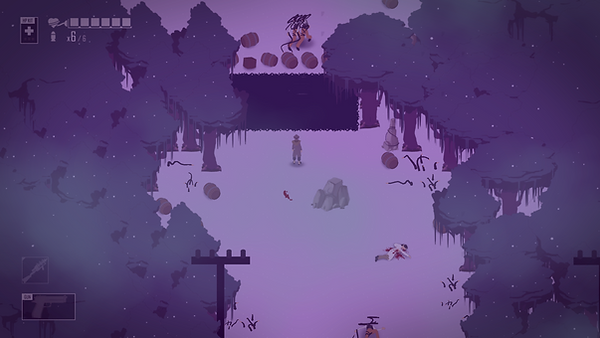
The Tutorial Level, part 3 - giving motivation through story and introducing a gun
The focus of the last part of the tutorial level:
-
Continue the story from the intro cutscene by having a major in-game story beat where the detective finds the scientist he's been searching for. This serves as a bit of a twist from the intro, and shows that important story clues might be encountered in the game world. The scientist is dying, tasking the detective with warning the mainland of what's happening at the island - in order to give the player a proper motivation to brave the island's dangers and get away with their life.
-
Introduce the gun and include a skillgate of it's use in order to move forward. After the skillgate the player also encounters some enemies to test out their gun on.
The player has just found the gun and has to use it to shoot the barrels so he can jump to the other side.
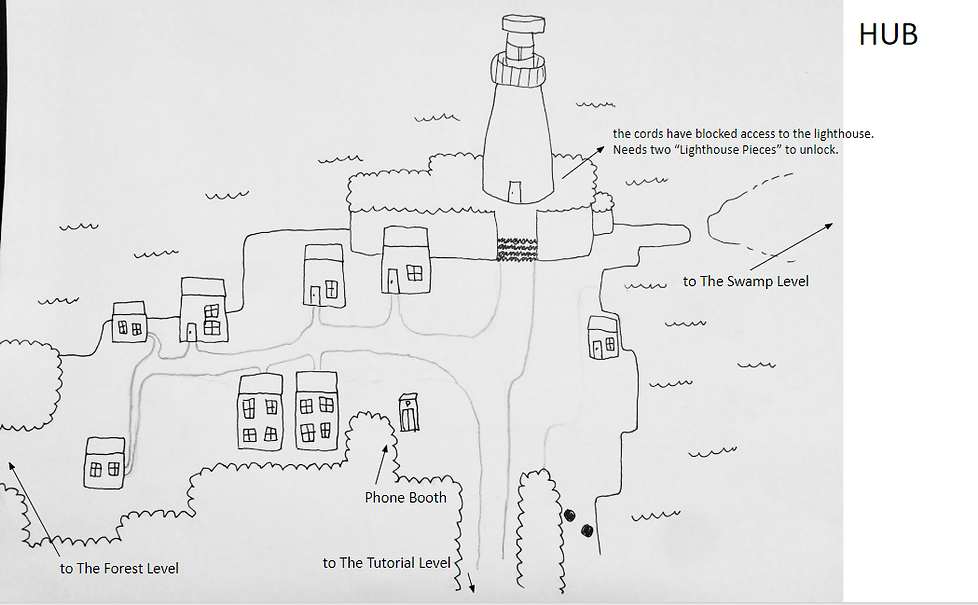
A first version of the HUB area. The telephonebooth later got moved closer to the lighthouse so that the symbols outside the lighthouse door would be visible as the player gets teleported to the telehonebooth.
The HUB
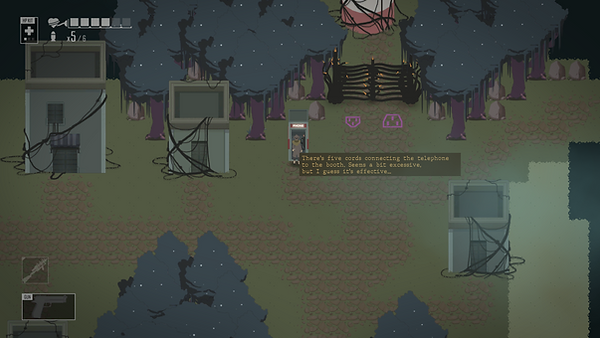
The HUB level mainly served as the returning point for the player between levels. This is what I wanted to accomplish with the HUB level:
-
Establish the blocked path to the lighthouse as the game's final goal. To do this the road to the lighthouse is quickly visible after the player enters the area, and it is straight forward. It has two weird symbols in front of it (which start to shimmer as they are unlocked) that draws the players interest. And as the player walks close a dialogue text automatically appears, having the detective comment on the blocked road to the lighthouse.
-
After completing a level the player will get transported back to the HUB and arrive at the telephone booth. So I wanted to highlight it so that the player has investigated it and know that it exists. Placing it right beside the entrance to the lighthouse made sure that most players would see it. You can also interact with it to get some flavour text.
-
Make it feel like a small village.
-
The HUB area has roads to the two big levels, and I wanted the paths to the levels to feel different and appropriate for the area they lead to. The road to the forest level has a lot of trees, and the road to the swamp area have you jumping across water onto a narrow piece of land.
-
It is possible to talk to the inhabitants in each house, and to showcase this the path to the first level first leads the player through the village, where they come across most of the houses in the village.
The player interacts with the telephone booth, right beside the entrance to the lighthouse.

Designing Enemy Zones
In the game there are several "Otherworld" levels, these lead to switches that make cable doors disappear. These levels are often short, and focused on enemy encounters. During the game I designed several of these levels.
Overwhelmed by bullets
The player has to quickly dash over small platforms while being shot at from several angles - making it very perilous to stand still for even a second.
The platforms with the ranged enemies are not reachable from the player's middle platforms, but for the completionist they are reachable from the top of the map, making it possible to jump to each platform, and also by doing this find a health potion.
The level is very fast paced and quite short.



Horde-control
The player first has to fight many Melee Enemies on cramped islands.
The player then arrives to the big room and has to navigate fighting very many enemies on the same island. I wanted to make the player dance around the room, dashing away and trying to horde control the enemies. To make this dance more interesting there’s a hole in the middle of the room.
In order to make progress the player has to shoot some barrels and activate a switch. This is located at a part of the level that's not obvious that it's needed for progress, and it's a bit time consuming - because I wanted to make it hard to make progress without killing at least a significant number of the island's enemies.


Ranged enemies placed to defend their island, forcing the player to first avoid their bullets, and then time his jump over to the island or time using his gun on them.

Ranged enemy that you only can kill using your gun.
Labyrinth
The player has to navigate a labyrinth of trees to find the switch that will take them out of the labyrinth.
The level is designed to be very hectic. Enemies can shoot through the trees - forcing the player to try to quickly finding their way and raising the stakes when the player ends up in a dead end. Dead end often gives you health or a secret though, so as not to annoy the player too much.

The switch needed to exit the labyrinth is visible early on, but it's a bit tricky to find the way leading there.
Level Art to guide the player
Symbols and the use of the brick road
To guide the player in the sprawling "normal worlds" we made use of the brick road as a navigation point. The broadest part leads to the main gate of the area, which you have to find three switches to unlock. Smaller parts of brick road lead to the switches, and where there's no brick road secrets can be found. This worked well to make it possible for the player to get a feel for the area, while still have to figure out exactly how to navigate it.
To further help the player navigate, and not return to the same already explored area too many times, we used the symbols for the switches to indicate which switch can be found in witch direction. The symbols for already turned on switches start to shimmer. Some players just ran around until they found the way, while players who payed more attention to their surroundings could figure out how this worked and be greatly helped by it.
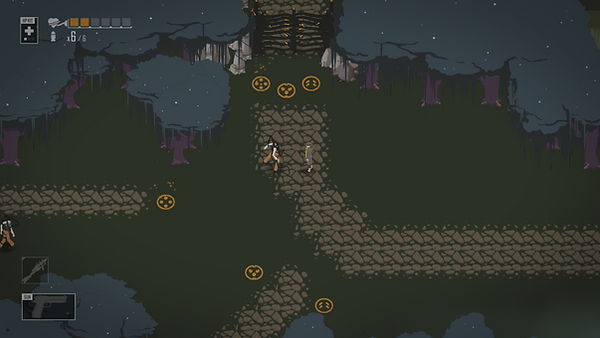

Guiding with cable doors
The player has to use switches to turn off the cable doors and progress through the level. To indicate where switches for certain doors can be found we placed the doors of that color in the direction that switch can be found. This also helps the player remember that they already have gone that way.
We made sure that wherever there was a switch a door of the same color could always be seen, so that the player got a visual confirmation of the door disappearing as they turned off the switch.
Creating an Otherworldly atmosphere
We wanted the otherworld areas to feel different from the normal world. Besides from another color scheme we used props differently in them to convey that thay follow another logic.
-
Telephone poles are placed in weird patterns to create a surreal feeling.
-
Stones and islands are often symmetrically formed, going against how nature is normally formed.
-
We made use of our cable-grass prop a lot in the otherworlds and around the portals leading to the otherworlds.
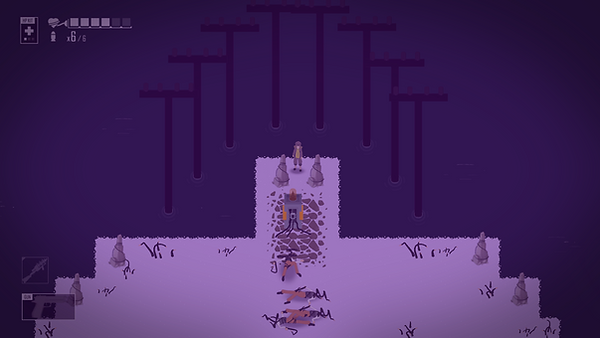
Narrative
"Remember THE WORDS: Always be a Good Believer. To always keep your mouth wide open is to be a Good Believer - show the cables the WAY IN. Your mouth is a gate between worlds."
I wrote a lot of text for this game, and placed it in the game to get the desired pacing.
"Mommy says it’s nothing to be scared of. Our souls are electric, just like the Great One, so it’s just very natural. She says that It will make us more free which is always good because trapped is bad. And we will be on another kind of plane, like another floor, but higher up. I wish I wasn’t so afraid. I want to be brave and free like mommy."
Narrative Guidelines
To make the atmosphere of the narrative cohesive I set up some guidelines:
-
Always highlight that what's going on at the island is strange and horrifying. The Detective shall feel appalled by the weird things he finds, and feel uncomfortable on the island.
-
Give everything a gloomy touch. Things are damp, dark, muddy, rotten etc.
-
Always make the Great One feel mighty and terrifying. Everyone on the island talks about it with reverence, and in time even the Detective can't stop himself from talking about it with awe.
Overview of story beats in different levels

"My hands were trembling as I pressed the receiver against my ear. The static just continued to grow, becoming overwhelming, flooding my brain with wave after wave until I was drowning under too much noise."

"There’s a strange mark in the sand. It almost looks like a spiral, but broken. Staring at it for some time I get a feeling of weightlessness."
What I've Learned
Changes I'd make
-
Include a twist in the story, towards its end.
-
Design more enemy zones to encourage the use of the pistol, as it's now many players only use the melee option.
-
Designing a 2D top down world.
-
Designing several different levels to make encounters with two different enemy types as varied as possible.
-
Iterating mazelike levels to make them easier to navigate.
-
Integrating and writing text to deepen the game's world and atmosphere, and also give a sense of progression.
-
Keeping a coherent tone in narrative throughout a short game.
Thank you for your time <3